Apple iPad mini with Retina Display: Reviewed
by Anand Lal Shimpi on November 16, 2013 8:00 AM ESTThe SoC
The iPad mini with Retina Display rounds out the three platforms that use Apple’s A7 SoC. Although both the iPad Air and iPhone 5S use the A7, the mini’s implementation is closer in nature to the iPhone. The iPad mini’s SoC has always used the same package-on-package (PoP) assembly as the iPhone, with DRAM stacked on top of the SoC itself (1GB in this case). The benefit is obviously a reduction in board area, the downsides have to do with cost and thermals. That’s the first similarity between the mini’s A7 and the iPhone’s A7.
The second is one of frequencies. While the iPad Air’s A7 runs its two Cyclone CPU cores at up to 1.4GHz, the SoC in the iPad mini and the iPhone 5S runs at up to 1.3GHz. That might sound like a minor difference, but it’s far more pronounced when you look at what happens to frequency when you’re running heavy workloads.
Once again I turn to a fairly heavy CPU workload to plot performance over time. This is a multithreaded workload, slightly modified from what we used in the iPad Air review, designed to make the CPU cores consume max power. The scale is linear and the workload is the same across all devices, so what you’re effectively looking at is a graph of thermally bound CPU performance over time across all three A7 implementations:
Being the largest device (and the only device with a metal heat spreader and no DRAM stacked on top), the iPad Air obviously maintains the highest frequencies for the duration of the test. The iPhone 5S, with a significant reduction in internal volume (and a PoP SoC) reduces its CPU frequencies early on in order to keep skin temperature down and properly manage thermals. The iPad mini with Retina Display falls between the two, with its performance curve more closely following that of the iPhone 5S.
Although the mini has a similar max operating frequency to the iPhone 5S, it is a faster device thanks to it being less thermally constrained. Similarly, the iPad Air can be much faster than its clock speed would otherwise imply. If you’re wondering why Apple has been so focused on building its own SoCs and CPU architectures, this is the reason why. There’s a fixed amount of power you can dissipate in the form of heat in these mobile devices while still maintaining a good user experience. Performance per watt is the gating metric for success in mobile, and shipping high IPC/low frequency dual-core SoCs at 32/28nm is the best optimization available to a company like Apple today.
As you’d expect, our browser based CPU tests show the mini’s A7 performing in between the iPhone 5S and iPad Air. None of these tests are anywhere near as stressful as our thermal test from above, so we don’t see exaggerated differences in performance between the platforms. For most, I suspect you won’t notice a huge performance difference between the mini and Air. Those who are heavier users (e.g. audio mixing, 3D gaming, etc…), there will be a performance difference between the two iPads.
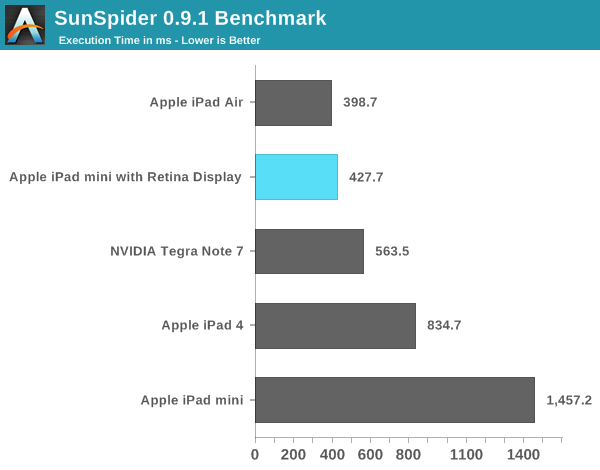

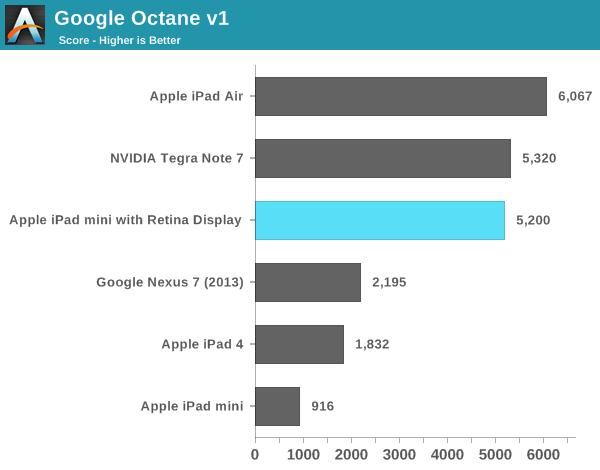
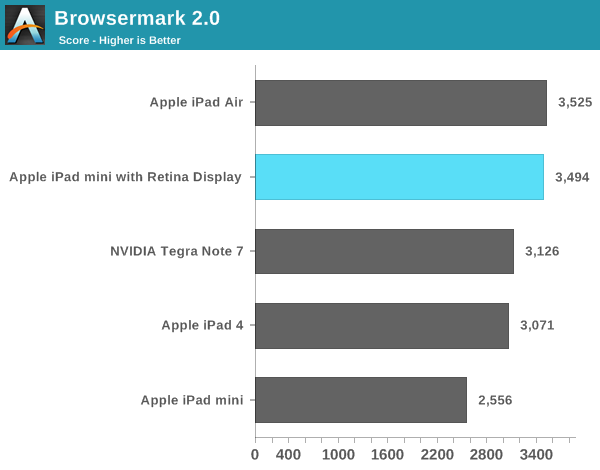
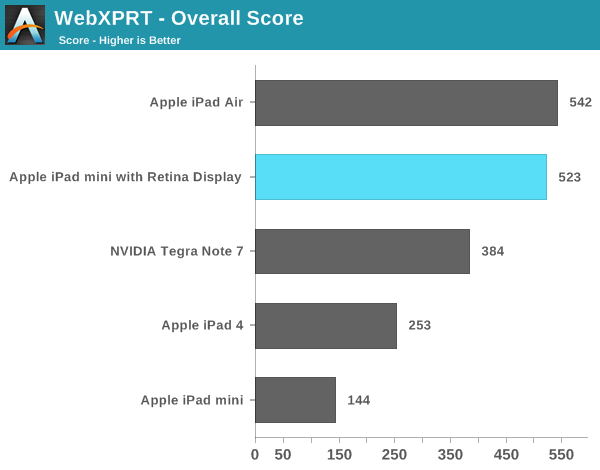
Compared to the first generation iPad mini, the new model is in a completely different performance league. Keep in mind the first mini used Apple’s A5 SoC based on an ARM Cortex A9. That’s the same single threaded performance as what’s in an iPhone 4S, and under iOS 7 it’s clearly running into some performance limits. The new mini with Retina Display however is a completely different animal. It’s fast.
Even comparing to the 4th generation iPad, the new mini is noticeably quicker.
Memory Bandwidth
Looking at the iPad mini’s memory bandwidth curve, we see it tracks very closely with that of the iPhone 5S. This is a slightly modified version of our previous bandwidth test, and you can see peak usable memory bandwidth (from the CPU’s perspective) of around 10GB/s. The ~12GB/s area right before you get out to main memory is bandwidth to the A7’s 4MB system-wide cache that sits after the shared L2 and the memory controller. This cache appears to service CPU, GPU and ISP requests at least.
GPU Performance
I believe the A7’s PowerVR G6430 GPU runs at around 450MHz. This frequency appears unchanged across all three A7 implementations. Once again, the big difference is how much thermal headroom exists in the platform which has an impact on overall performance.
Kishonti’s low level GPU performance tests back up my assertion that GPU frequency is fixed across all A7s. The iPad mini with Retina Display delivers equal performance to the iPad Air. The bigger news here is that nearly all of the GPU bound 3D tests seems to peg the mini and Air as equals. These are some pretty intense tests, but it looks like on the GPU side there’s no significant throttling when running at full tilt.
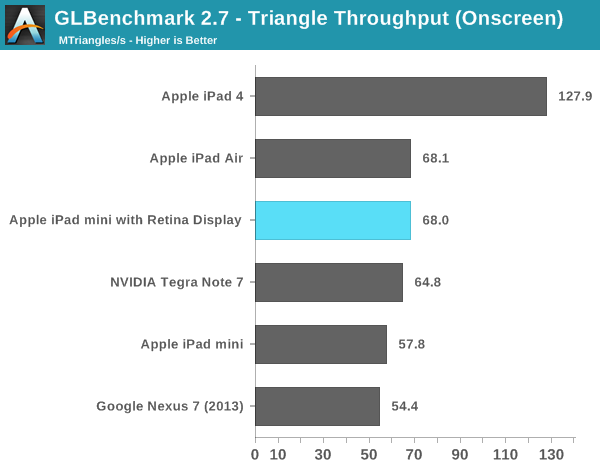

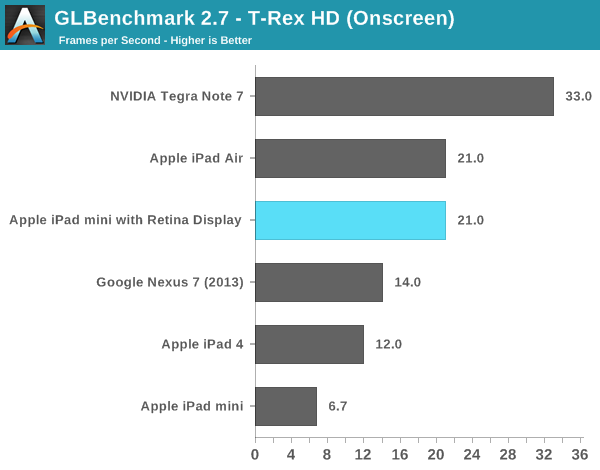

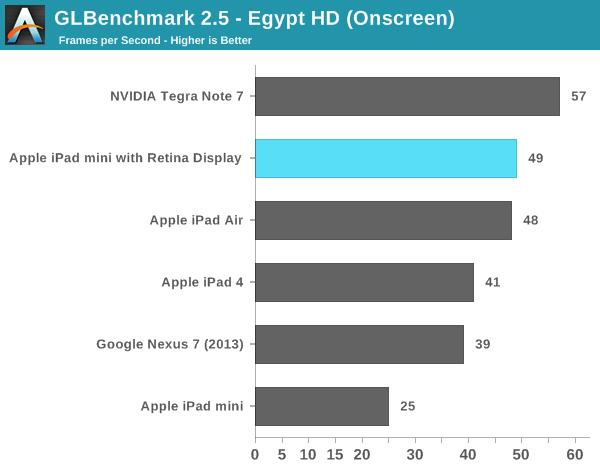
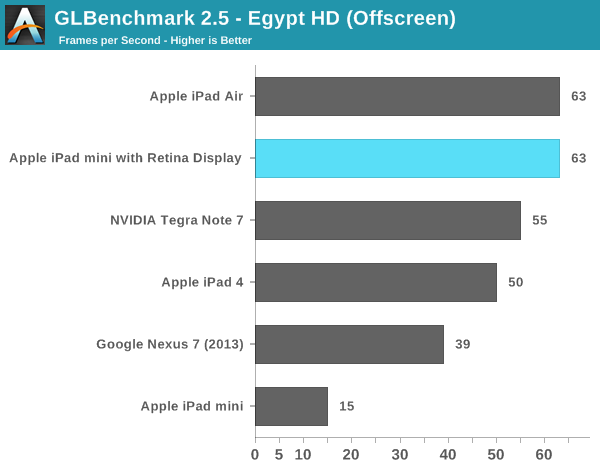
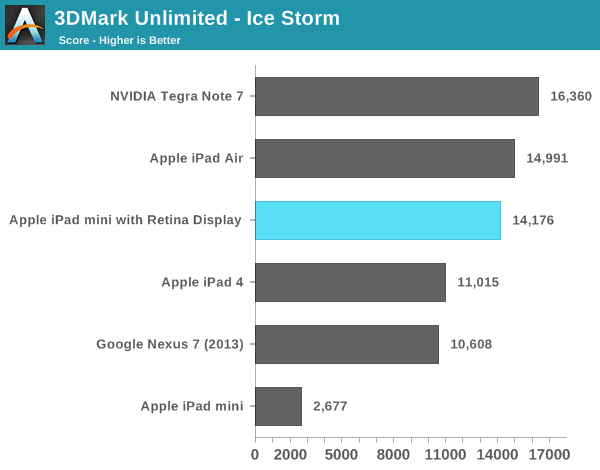
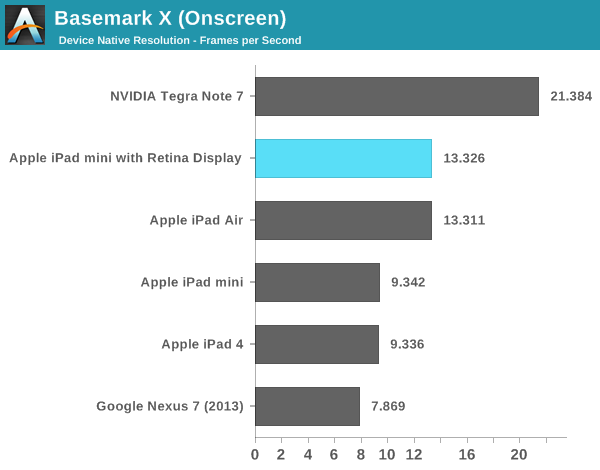
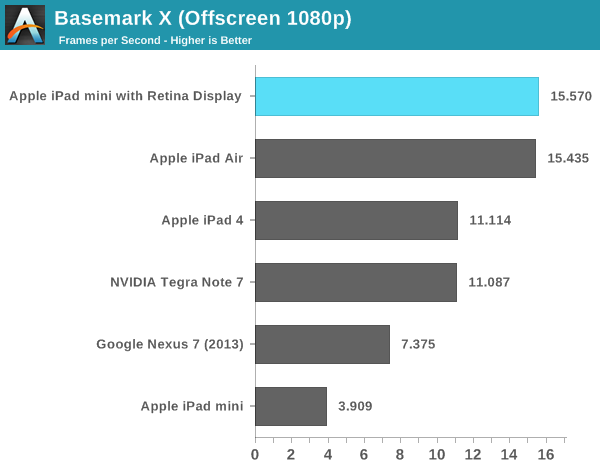
As I mentioned in our iPad Air review, despite having less peak theoretical memory bandwidth than the A5X/A6X, the A7 in the iPad mini never seems to regress in performance compared to even the iPad 4. Across the board the mini appears to be faster, more responsive and have more performance on tap than any prior iPad (big or small). The comparison to the original iPad mini is of course night and day. Even looking at lighter tests like the old GLBench Egypt HD benchmark, the iPad mini with Retina Display manages to be nearly twice as fast as the original mini - all while rendering 4x the number of pixels.


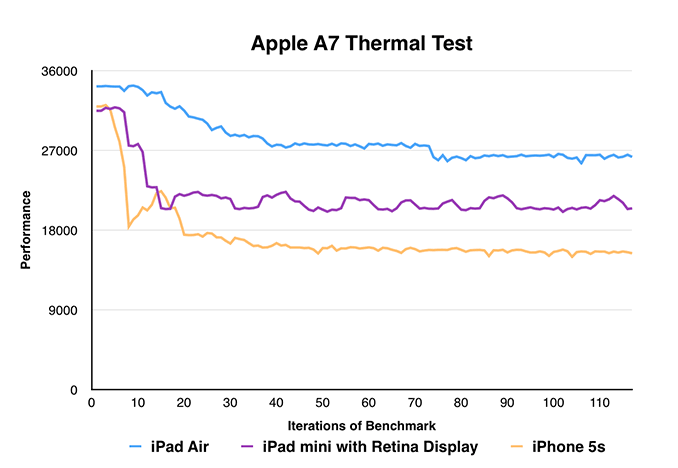
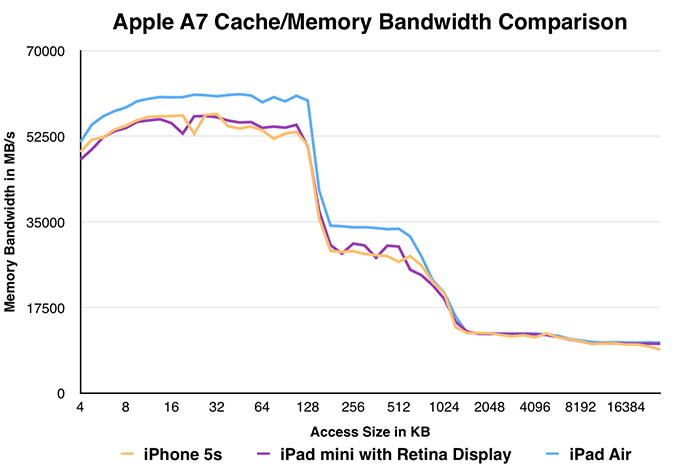








345 Comments
View All Comments
ELPCU - Tuesday, November 19, 2013 - link
Do research before talking about my knowledge or grammar.I am sorry about not born in US, so I have some grammer issue, but that does not make ur argument right.
I will tell you some of real number.
Source is IHS isuppli.
http://www.isuppli.com/Teardowns/Pages/Top-Stories...
They have done a clear analysis.
If you want to argue this number is wrong, you should bring some kind of real number with decent source.
Bill of material + manufacturing price of iphone 5s is 199bucks, while galaxy s4 BOM + manufacturing cost 237bucks. And I just check price of S4, which is 99 bucks with 2 year contract.
Oh, I have not mentioned that S4 has SD card slot, so you do not have to worry about paying 100~200 bucks for extra storage.
I know there are more expensive phones, mostly phablet. and I am sorry I do not have data for those expensive one, but their overall components cost & manufacturing cost generally more expensive than that of iphone, and those price usually go down eventually before new one release, while iphone price stays same until new iphone is released.
When I buy it, my HTC One price was 199 with contract, and now, it cost 99. Oh, by the way, HTC One does not have SD card slot, but it does not have 16GB model, but 32GB or higher. Do you want to compare it with iphone 32GB?
New HTC One Max-phablet-now costs 149. Any more question?
akdj - Thursday, December 19, 2013 - link
Your (their) numbers are wrong. Apple isn't disclosing the pricing in the aluminum process, anodizing, chip construction NOR are they 'selling' them in bulk to you and I. I own a Galaxy Note3 and a 5s. There's no way in HELL the BOM of the S4 is higher than the 5s. Or the 5c for that matter. Doesn't take a genius to see Samsung's build quality isn't top tier. Displays are killer. Nice SoC. But the plastic's gotta go! And those numbers are assuming a LOT, considering an A7SoC isn't available. Nor is the calibrated screen, casing, proprietary schematics, etc. not sure what your point is herefarhadd - Monday, November 25, 2013 - link
I'm sure if LG, HTC, Samsung, etc could sell their products with the same margins they would. Apple has a monopoly on the iOS market, and thus can charge whatever they like and people have to pay it if they want the product. If Samsung wants to introduce a revolutionary proprietary mobile OS and charge through the nose for that product, they may certainly do so. As it is they have competition to worry about.ELPCU - Thursday, November 28, 2013 - link
You are right. Most companies want to perform monopoly if they could(for example, if it is legal).But this does not mean doing monopoly is a good thing.
Apple is not performing monopoly throughout whole smartphone market, so Yes, they are doing nothing illegal, but they are doing something ridiculus. At least I can say it is a bad thing. Criticizing those ridiculus price policy is a totally fair thing to do.
Especially, considering all freaking apple product reviews became deceptive, pointing out the fact that Apple's pricing policy is ridiculus is fair. Why? because all reviews talk about price/performance with lowest storage iPad, and very strongly recommending it.
I am tired of typing out same thing. so here is another copy paste
"16GB is just not enough for iPad user. And review talks about Price/performance considering iPad cost just 499. To me, it just sounds like iPad cost starts like 599. Not just because 16GB iPad user feels lack of storage but also because Apple is intentionally holding its storage. 16GB was first gen iPad's base storage. IT IS STILL SAME for 5th generation!!"
I will still buy ipad, and still recommend it for user who seek decent entertainment device, but I am not recommending it super-strongly, because its price is really deceptive.
By the way, It is really interesting.
My point of first comment was simple as hell.
"ws3 was FREAKING WRONG AS HELL, and Apple's pricing is ridiculus."
He said "Apple's margins are not insanely high, as proven by the fact that for most of their products, they sell everything they make. How long has the iPhone 5s been out now and most Apple stores still can't keep them in stock."
Do you agree with him? You probably don't.
and NO ONE is properly arguing my main point.
However, bunch of guys pop out, and start to misinterpret my comment.
Let me summarize them all, and do slightly different short answer again
puggsly : No, he did not mean that
My answer : WTF? go back and read his comment again
Freerange1 : U failed blah blah
My answer : meh
akdj : I AM APPLE FAN BOI!, There is nothing wrong about a company making money! and BOM is not accurate way to measure margin"
My answer : OK. dude. but whole point of my original comment was about the fact that Apple has insane margin rate, and its price is ridiculus. statement 'its price is ridiculus' is more personal opinion. I still think most people will not disagree Apple's pricing-especially storage-is just ridiculus, but since you admit you are a big apple fan. let's put this opinion on the side
Do you disagree Apple have large margin rate? Probably u can't. Aren't u? that's reason why u bring out 'nothing is wrong about making money(having large margin)', because you cannot directly say Apple does not have large margin.
Plus, Look at your expression. What "Apple DOES make money"?
Oh, how cute. Again, let's face it. right expression is "Apple make A TONS OF money". Try not to hide what you see.
darwinosx : Your numbers are wrong, and your grammer is wrong too!
My answer : Any decent source? I used decent source from Market research site.
Sorry for wrong grammer though.
farhadd(YOU) : IT IS COMPETITION! A company can charge whatever price they want you to charge!
My answer : MY MAIN POINT was 'Apple has insanely large margin rate, and its pricing is ridiculus.' At least, I had not said anything about "having large margin is wrong" or made similar statement in my original comment. AND ALSO, as I have mentioned I bought iPad 4th gen a year ago, and now I have iPad mini Retina 128GB.
As a customer, can't I say its price is ridiculus?
It seems if ur friend say "I bought this, but it was terribly expensive.", are u gonna answer "All company has right to decide price of their product. If it is terribly expensive, don't buy it and don't talk about it anymore" something like this?
Yes, I probably used too harsh expression, but this is because ws3, whom I originally disputed, said something TOTALLY WRONG. Still, I might used too damn extreme expression, but I do not think I said something wrong. Do you think ws3 is right?
Although I have picked up, and answered every single bit of those comments. None of you guy is properly(I mean with decent evidence) disputing my MAIN point.
I am stoping HERE, because I feel none of you guy can disagree my main argument reasonably.
I apologize for my harsh expression, but I feel you guys are enthusiastically excusing Apple rather than having disputing, which make me to use even more damn BS expression.
ekotan - Tuesday, December 17, 2013 - link
I understand your point, but I don't see why it matters. Tablets are luxury products, not necessities; and all luxury products, by definition, command high margin.Yes, the margins are high. So what? People don't make purchasing decisions based on the manufacturers' margins, they make purchasing decisions based on the price of the product and its (perceived) value & benefits.
akdj - Wednesday, December 18, 2013 - link
Interesting comment considering ALL flagship phones are charging $100 for each storage increase. As well, their non subsidized price being essentially equal! HTC One, S4, Note 3, G2---all $650-$700 phones, identical to the iPhone. WTF are you throwing a tizzy about? Smart businesses make money. Smarter businesses make more money with better products. Pretty simple, actually common senseguardian1935 - Tuesday, March 11, 2014 - link
Your ridiculous spelling of ridiculous is ridiculous, sir.ELPCU - Monday, November 18, 2013 - link
Winkgood // For iPad mini, I think it is sort of excusable.Yes, I sort of understand your argument as well.
Apple generally keep price same. But note original ipad mini cost was pretty low. Not just in terms of absolute price, but also in terms of margin, its cost is not that high. 1st gen iPad mini has lowest margin rate among iOS device, which is still decent amount of margin.
But making it as Retina cost a lot, as Mahadragon mentioned.
Also, comparing increasing resolution of phone and iPad mini is not same. iPad mini has significantly large display with more pixels, which means diplay cost is much bigger matter for iPad mini, and battery size is bigger issue as well.
Yes, iPad has not increased its price when it move into Retina display, but they sacrificed significant amount of margin per unit for that one. And iPad mini does not have that 'extra margin'.
I cannot say too much about margin rate of iPad mini Retina since I do not have accurate number, but during iPad 3rd gen has about 40 bucks higher bill of material. compared to BOM of iPad 2 just after iPad 2 release. It refers Apple had to spent 40 bucks more for each iPad, which means they gave up about 60 bucks per unit price. Considering resolution of iPad mini and iPad are same, despite of size difference, I expect similar or slightly lower BOM increase.
If Apple do not increase price to negate those manufacturing price, iPad mini 16gb wifi will go in about 'zero margin' area.
Apple can still makes some money with their storage pricing(yeah, 100bucks per every bit of storage!! that's what I call rip-off! ), accessory, and App selling, but I do not think Apple is a company who want to sell zero margin tablet, and I do not think it is wise in terms of company strategy, considering current apple's position--strongest company in tablet market.
puggsly - Monday, November 18, 2013 - link
I was wondering how Apple would both increase resolution and bump the CPU to the A7 and was surprised at the solution of upping the price. Not that it wasn't a good compromise but I'm afraid that Tim Cook is paying too close of attention to margin and missing the revenue boat. If people remember how shocked the tech community was that the first iPad hit a $499 price point at 16GB of storage, you know that Apple was charging a premium price for a premium product but that it was seen as a good value. Now here we are almost 4 years later and the entry level iPad and iPad Mini are 16GB!!! 4 years ago 16GB went further than it does today and Apple NEEDS to shift the entry level on it's products to continue to push the idea of Premium value.For many users 16GB will not be the premium user experience Steve Jobs demanded and Cook needs to balance that with margins. It will piss off some consumers but this can't wait till the next annual refresh. So maybe Cook does a Feb/Mar spec bump on the line to double the Storage and keep the price.
Also, the cost of the cellular options needs to shift down to $70-$99 because the high end purchasers are going to balk as the price point climbs....I know I am. $629 for the 32GB mini with cellular is a tough choice. But at $499 I might end up with two this christmas.
darwinosx - Tuesday, November 19, 2013 - link
Iv'e bought four Nexus 7s as gifts but prefer the Mini for myself. 35% more screen space is a big deal and the apps are better with more selection. It's also quite a bit faster than the Nexus 7 which is very apparent if you have used both. The Nexus 7 is sold at cost so it's an amazing value but it also feels cheap compared to a Mini.